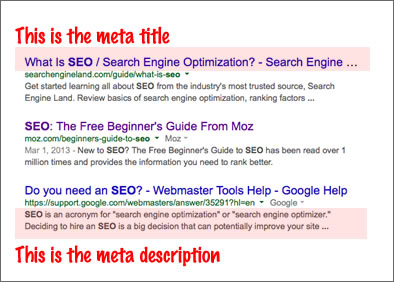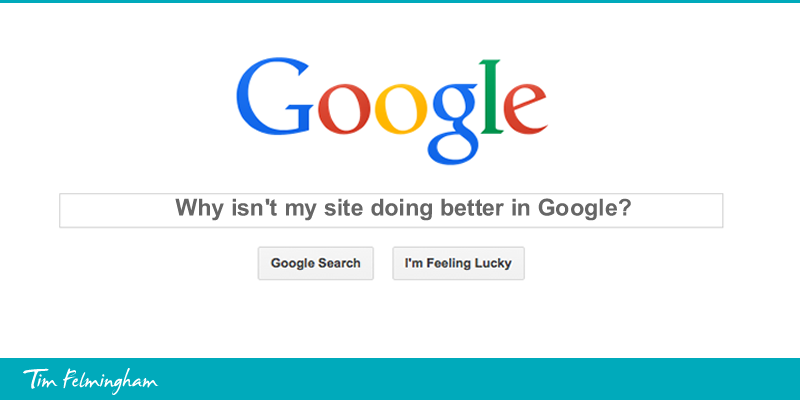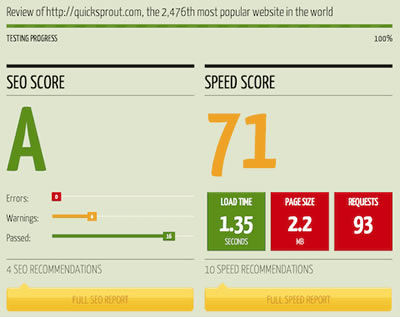Why isn’t my site doing better in Google?
That’s a question I hear all the time. Let’s face it, it’s the Holy Grail. However well you’re doing in the search engines, everybody always wants to do better. This gave rise to a whole industry — Search Engine Optimisation or SEO. The first thing to do is to check that your SEO has done the basics correctly — often they haven’t.
The SEO’s job is to improve your rankings in the search engines, and thereby send you more traffic. It’s an important job as it can make or break your success online, however it’s a bit of a strange job…
No SEO can ever promise results, they can only do all the right things and hopefully, in time the rankings and the traffic will come. Google permitting. It’s part science and part art, it takes a lot of skill and knowledge, and even if you do everything right, it doesn’t always work. And the results can take time to show.
That makes it very difficult for you, the client, to tell whether or not your SEO company has done a good job for you.
If your results are not what you hoped for, what should you check?
If you’re not interested in the background and just want to get straight to the bottom line, miss out the next bit and scoot down to ‘Four things your SEO company should have done‘ below. If you want to really understand the whole situation and what your SEO company should be doing TODAY then read on…
How SEO works in 2018
Firstly you need to have an appreciation of what Search Engine Optimisation is, and what SEOs are trying to achieve.
The SEO landscape is constantly changing, as Google continue to improve their search engine in their quest to deliver the best possible results for searchers. Their goal is for you to find exactly what you are looking for every time you search. As you can imagine with something like 4.1 billion pages on the web, finding the one that contains exactly what you are looking for is no trivial task.
Google and the SEO community play a constant game of cat and mouse, as SEOs find ways to manipulate the system and boost their rankings, and Google finds ways to stop them. That dance has gone on for years, but as Google have increased the sophistication of their algorithms to the point where it’s become virtually impossible to ‘game’ the system (and downright dangerous to even try), the music is coming to an end.
The only way to get good and reliable rankings in the search engines is to provide searchers with exactly what they are looking for.
Tricks such as keyword stuffing and mass link-building don’t work any more. They haven’t for a while.
The role of the SEO now is to facilitate the Search Engine’s discovery and cataloguing of your amazing content, rather than attempting to manipulate or force the results. You have to have the great content in the first place, the SEO’s job is to show Google how great it is by being aware of and addressing the ranking factors currently in use.
A word about Keywords
Until late last year, Google worked on the concept of keywords. Keywords are the search term that the user types into the search box. e.g. ‘cheap ipad mini’.
Because of the huge number of pages about iPads (roughly 883,000,000) it would be too ambitious to try to rank highly for the keyword ‘iPad’ unless you are Apple. There is simply too much competition.
So then what’s known as the ‘long tail’ of search emerged — more specific keywords such as ‘ipad mini retina 32gb cellular’ which are easier to rank for as there is less competition (only about one million instead of eight hundred and eighty million). Still not easy to rank for, so you can go even longer-tail — ‘ white ipad mini retina 32gb cellular for sale secondhand in doncaster’.
Now you have a chance of ranking. But there probably aren’t many people searching for this so even being number one wouldn’t be that valuable.
So what you did was to try to rank for many long-tail keywords, which added together amounted to a lot. You would create individual content around each of the long-tail keywords you had identified and try to rank for these keywords.
What’s different now is Google (and let’s face it there IS no other search engine) doesn’t work so much on keywords today. Instead Google is focused on answering the user’s question. In other words they are looking for pages that are likely to answer the user’s question rather than pages that match specific keywords.
It’s a bit of a subtle difference but it’s important. It’s good because Google is starting to act like a human helper rather than a machine, and hopefully the searcher (that’s all of us by the way) will stand a better chance of getting what they want.
So now we are organising content more around topics instead of keywords. Our page about iPads might have iPad specifications, iPad prices, iPad fault-finding tips, iPad tutorials, pictures if iPads and much more. Google might then reasonably assume that our page can answer pretty much any question there is about iPads. Keywords are still important to SEO and are used in much the same way but content (which is the true key to SEO) now needs to be organised slightly differently.
So now we know what Google is looking for.
Which funnily enough is exactly what customers are looking for.
On to SEO and what your SEO should be doing…
SEO Check: Four basic things your SEO company should have done
These are just the basics but they will give you an idea whether or not your SEO knows what they are doing. If they haven’t done the basics then there isn’t a hope in hell they’ve done the difficult stuff!
1. Develop a content and keyword targeting plan
OK, you want to get rankings in the search engines but what do you want to rank for? You need to work out and agree with your SEO exactly what you are targeting. Ideally you should do this together, as they will be able to advise you on which keywords (or topics) are worth trying to rank for because they will have data on how many people are looking for these things and how much competition there is. They are unlikely to have sufficient knowledge of YOUR business to be able to do it without you, and you probably don’t have enough understanding of SEO to do it without them so you need to collaborate on this. You need to work out what you are targeting and make sure you have keywords and content to match.
Does your SEO company have a clear, written content and keyword targeting plan? If not, then how on earth are they going to deliver the rankings you want?
Most people who are not getting the results they want, fail this simple question — they’ve left it to the SEO company to ‘do what they think is best’ or some such cop-out. Don’t do this! You cannot do SEO without this information. Period.
2. Ensure all of your relevant content is reachable and readable by the search engines
It’s no good having great content if the search engines can’t see it. Is all of your content readable by search engine spiders? Flash animations, audio files, videos and some javascript aren’t so these should be supplemental to your content, rather than essential.
Is all your content readable, linked to and organised so that the search engines can find it?
3. Setup Google Webmaster Tools and submit a sitemap
Google Webmaster Tools is a free service from Google to help website owners make sure their content is indexed correctly. It gives you the opportunity to tell Google about your site, for example which pages they should index, how often they should crawl them, what geographic territories you cover and much more. It will also tell you of any problems Google has encountered with your site and help you to fix them. Google will actually help you to get better results!
All too often this crucial tool and the vital information it provides is neglected. Ask to see Webmaster Tools for your site and have a poke around to see what it says. You may be surprised at what you find…
4. Basic (and essential ) on-page optimisation
This is the main signal that tells Google what a page is about. There are 5 key components:
Page Title (Meta Title)
This is the title that appears in the top bar of the browser window and tells Google (and the viewer) what the page is about. It also appears in the search results. This should accurately describe what the page is about. It should be unique (i.e. not the same as any other page) and should contain your main keyword or theme near the beginning.
Meta Description
This is a longer description of what the page is about. It should be rich in your chosen keywords but not unnaturally so. It tells Google what your page is about in a bit more detail than the title, but most importantly it’s the bit that people see in the search results page so it must attract their attention AND make them want to click on it.
For a great explanation of the importance of the meta description, and how to optimise it to get the best click through rate from the search engine results pages, see this article on meta descriptions from Nikolay Stoyanov.

Headings and body copy
Your main heading for a page, known as the level one heading or H1, should contain your main keywords for the page, again near to the start of the heading.
Sub-headings (H2, H3, H4) etc. should also contain keywords and should logically structure the content. This is your chance to include the other keywords around your topic. Your level 1 heading should contain your major keyword and all your subsidiary keywords should be in subheadings somewhere.
Body copy (paragraphs and sentences) should also contain your keywords, organised via relevant subheadings so your page has a clear and understandable structure. Write for people, not machines but the machines will appreciate it too!
Alt text
Search engines can’t see inside pictures (yet). Nor can blind people using a screen reader. Any images should have what’s called an ‘alt tag’ which is a short text description of the image eg. ‘ipad mini picture’. Again those alt tags should contain your relevant keywords
So the check here is to view the source of the page (how you do this depends upon your browser/operating system — Google it if you can’t see it in your browser’s menu). Find the meta title, meta description, H1 and other headings and make sure they contain the relevant keywords. Also check that any images have got alt tags, again with the relevant keywords.
Now I realise that at this point we may be pushing you into a level of geekery you’re not comfortable with — looking at HTML source code, but fortunately there is a much easier way to do this.
Simply run each of your pages through Neil Patel’s excellent SEO checker:
This will check SEO of your website and tell you all of these things, and much more besides. Just enter your web address and it will tell you what’s good and bad about your site from an SEO perspective, and will highlight any problems you need to address.
In fact I could have just sent you there at the beginning and saved all that reading but hopefully the understanding you’ve gained makes it worth the time you spent.
In some cases you may find that you now know more than your SEO!
If you want a more detailed explanation of how on-site SEO works, and to learn how to audit your site yourself, I can find no better guide than my friend Nik Stoyanov‘s excellent step by step guide to SEO auditing your website.
If you want to track your SEO success over time, you can check this article about the essential SEO metrics by Mangools.


